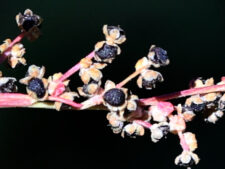
WOODLAND GOOSEFOOT
Chenopodium standleyanium
GOOSEFOOT FAMILY (Chenopodiaceae)
 Identification
Identification
- Flowering time - July to September
- Common in woodlands at FF & NW
- Leaf margins not toothed
- Leaves usually green underneath, not mealy white
- Lambsquarters looks similar - see comments
This slender, delicately branched native annual grows up to 4 feet tall. Alternate, stalked leaves are up to 3 inches long. Oval lower leaves often have a pair of shallow lobes just above their wedge-shaped bases. Upper leaves are narrower and smaller with smooth margins (C). Leaves may have a slightly white mealy undersurface, but are mostly green. Panicles of inconspicuous greenish flowers which have no petals occur in small tightly packed clusters (glomerules) along delicate branching stems (C,D). Each flower produces a single tiny seed, the persistent calyces wrapped around its base but not completely covering it (F). Stems often turn reddish at maturity (D,E).
Locally common, mainly in disturbed areas, in woodlands at Fontenelle Forest and Neale Woods. Flowering occurs from July to September.
Similar Common Lambsquarters (Chenopodium album) has prominently toothed leaves with white mealy undersurfaces, more crowded flower clusters and seeds that are completely hidden by the persistent calyces. Woodland Goosefoot also has a more delicate branching pattern giving it a more graceful look than Lambsquarters.
An alternate common name is Standley’s Goosefoot.






